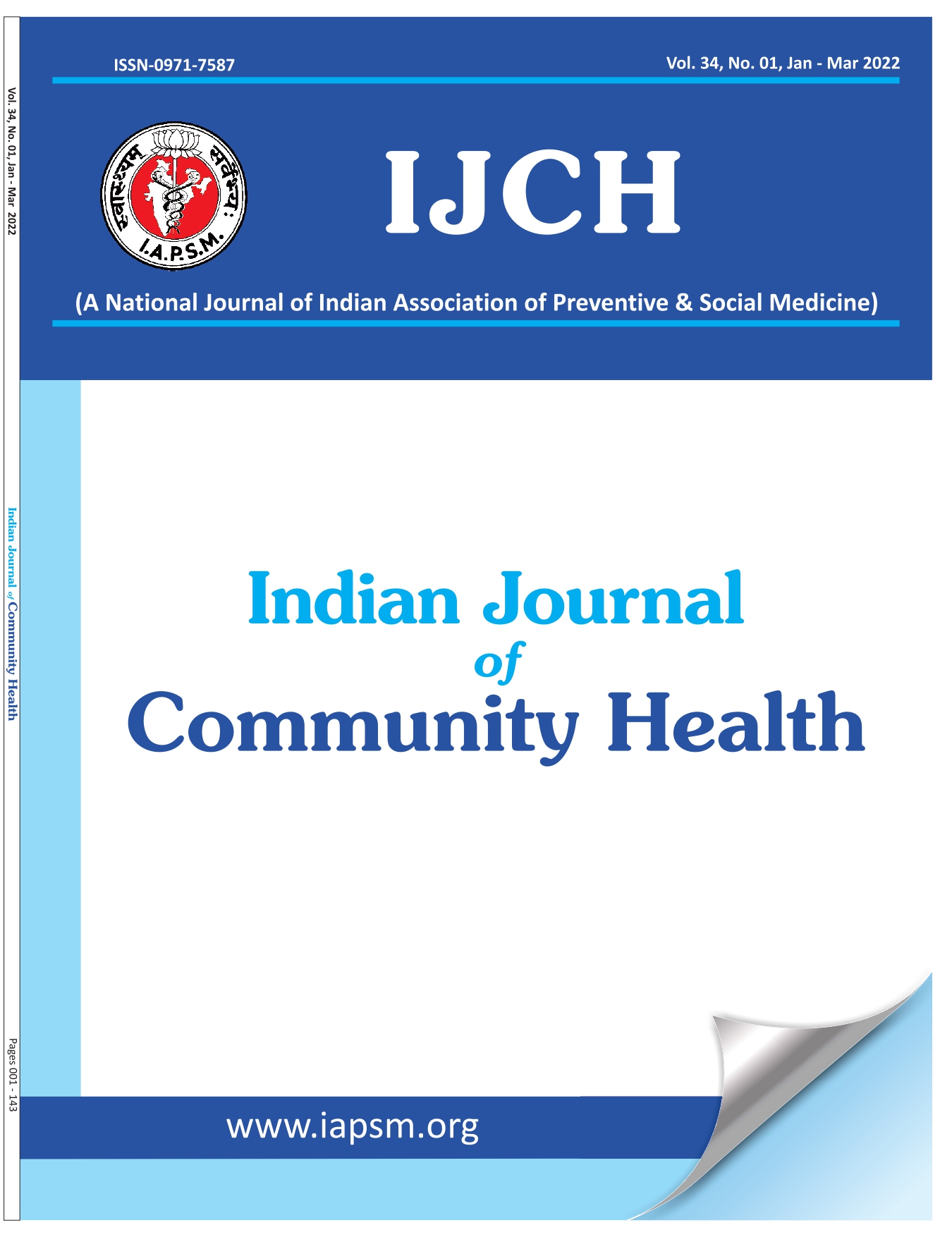Complacent Child feeding practices versus Infant feeding practices affecting the nutritional status of Under Two children situational analysis
DOI:
https://doi.org/10.47203/IJCH.2020.v32i01.010Keywords:
IYCF, Minimum Meal Frequency, Minimum Food Diversity, Complementary FeedingAbstract
Background: -To enhance child health, Indian Child Development Scheme (ICDS) and National Health Mission (NHM) strategized that reinforcement of Infant and Young Child Feeding (IYCF) practices would be a good take off. Anganwadis, where 78% of mothers of children below 6 receive services, can serve as an effective platform for mothers to receive counseling on appropriate breast feeding and complementary foods, in a priority state like Odisha. Aim: -As a prelude to a detailed intervention, a rapid baseline situational analysis was planned in 4 intervention districts to know about the district specific variations and also the overall IYCF practices in the area. Objective: Assess the IYCF indicators in the districts with focus on feeding practices above 6 months of age. Assess the factors responsible for breast feeding and complementary feeding in the sample Materials and Methods: - Final sample of 600 was chosen using 30 cluster sampling based on proportions of less than 2 years children in the study districts (districts named A-D, as the interventions are in progress and state refrains the identity of districts), 30 clusters to be divided in the ratio of 10:8:5:7. From each cluster-mothers of 20 children, nearly equal proportions of children in 0-6months and 7-23 months, were interviewed for sociodemographic, health seeking and prevailing IYCF practices. BMI (Body Mass Index) and MUAC (Mid Upper arm Circumference) were used to corroborate the nutritional status of child. Results: - 606 interviews were conducted. Age groups ratio was 2:1.5. Exclusive breast feeding was noted at 68% and under nutrition was 59.2%. Advanced maternal age were positively associated with declining breast-feeding practice; however good spacing and male child was protective for good IYCF practices. The complementary feeding practices, measured with 2 major indicators i.e. Minimum Food Diversity and Minimum Meal Frequency, were calculated as 40.7% and 20.6% respectively. Gender representation for both indicators was positively skewed for females, which was reasoned in FGDs as purely by chance and did not mean a preference for boys. Both service provider and the mothers’ knowledge was compromised regarding complementary feeding indicators, in spite of the fact that former had been trained on this aspect. Conclusion: - Targeted interventions are envisaged as scope for improvement in the IYCF indicators in the mixed mileu of a state, wherein some districts indicators markedly affect the overall state indicators. In Odisha, this study may give guidelines to the intervening districts to overhaul the load of under nutrition which is now more district and select population specific.
Downloads
References
Sample Registration System (SRS ... - 2011 Census of India.http://censusindia.gov.in/vital_statistics/SRS_Bulletins/Bulletins.html (accessed April 9, 2020).
Global Strategy for Infant and Young Child Feeding - UNICEF.https://www.unicef.org/nutrition/files/Global_Strategy_Infant_and_Young_Child_Feeding.pdf (accessed April 9, 2020).
Khan AM, Kayina P, Agrawal P, Gupta A, Kannan AT. A study on infant and young child feeding practices among mothers attending an urban health center in East Delhi.Indian journal of public health. 2012 Oct 1;56(4):301.
UNICEF, 1986, How to weigh and measure children: assessing the nutrition status of young children.
UNICEF, 1986, How to weigh and measure children: assessing the nutrition status of young children
de On is M, Onyango AW, Borghi E, Garza C, Yang H for the WHO Multicentre Growth Reference Study Group. Comparison of the World Health Organization (WHO) Child Growth Standards and the National Center for Health Statistics/WHO international growth reference: implications for child health programmes. Public Health Nutrition, 2006, 9:942–7
Patel A, Badhoniya N, Khadse S, Senarath U, Agho KE, Dibley MJ, South Asia Infant Feeding Research Network (SAIFRN)*. Infant and young child feeding indicators and determinants of poor feeding practices in India: secondary data analysis of National Family Health Survey 2005–06. Food and nutrition bulletin. 2010 Jun;31(2):314-33.
Sinhababu A, Mukhopadhyay DK, Panja TK, Saren AB, Mandal NK, Biswas AB. Infant-and young child-feeding practices in Bankura district, West Bengal, India. Journal of health, population, and nutrition. 2010 Jun;28(3):294.
Paul K.H., Muti M., Chasekwa B., Mbuya M.N., Rufaro M.C., Humphrey J.H. et?al. (2010) Complementary feeding messages that target cultural barriers enhance both the use of lipid?based nutrient supplements and underlying feeding practices to improve infant diets in rural Zimbabwe. Maternal and Child Nutrition 8, 11740– 18709
Downloads
Published
How to Cite
License
Copyright (c) 2020 Indian Journal of Community Health

This work is licensed under a Creative Commons Attribution-NonCommercial-NoDerivatives 4.0 International License.





